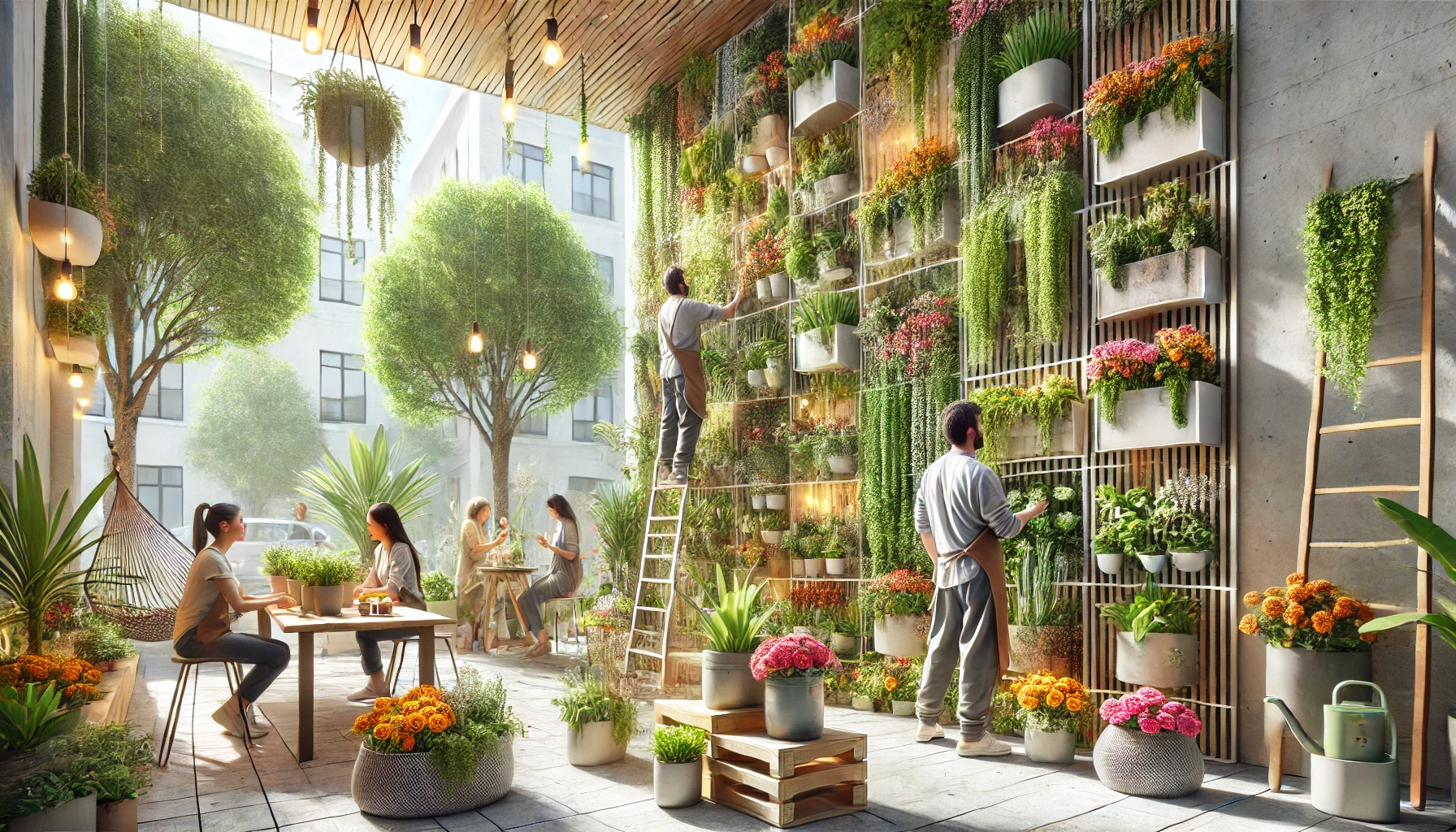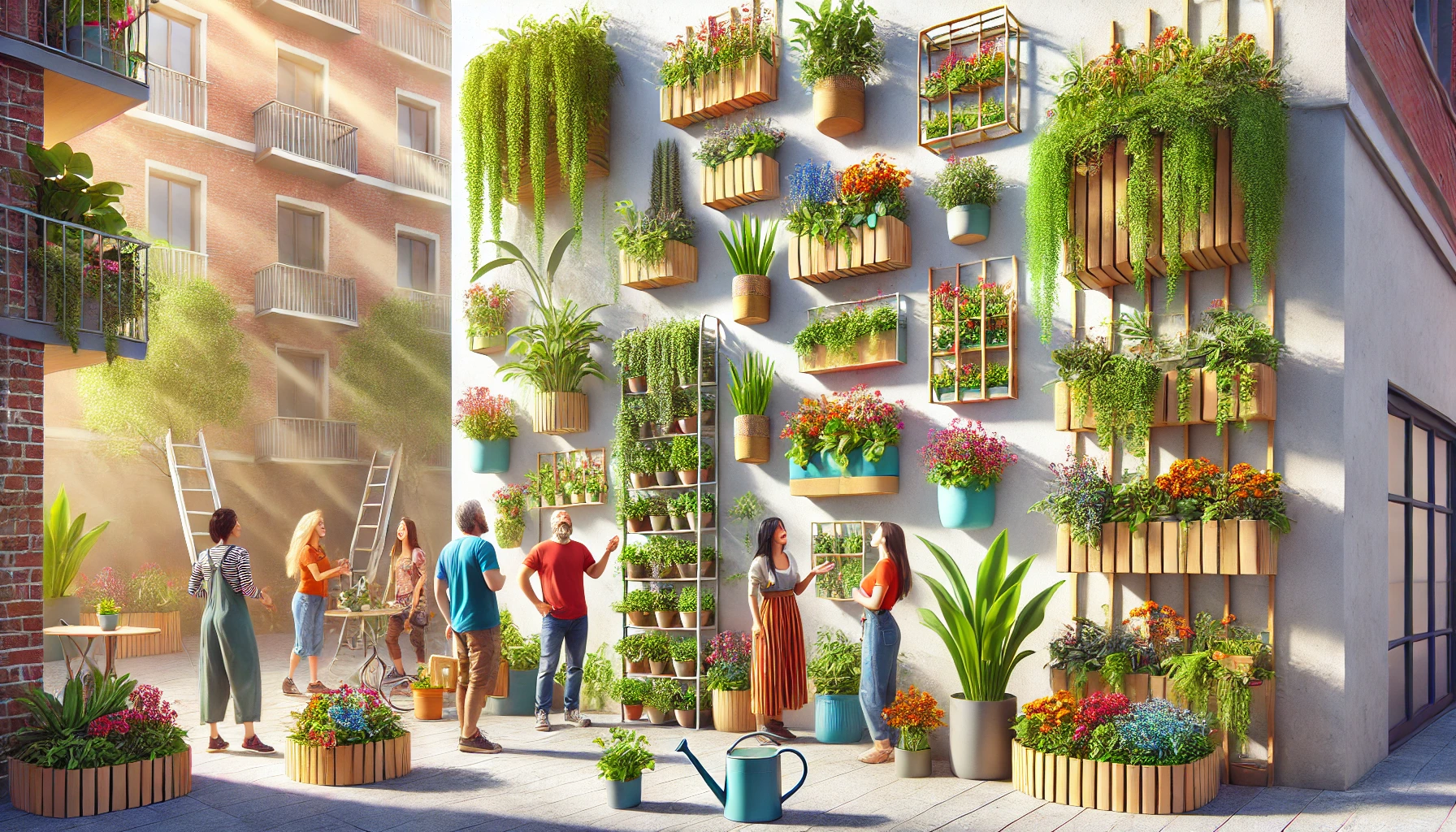In the face of rapid urbanization and shrinking living spaces, urban dwellers are turning to innovative solutions to incorporate greenery into their lives.
One such solution is vertical gardening, a method that combines practicality, creativity, and sustainability.
Vertical gardens transform walls, fences, and other upright structures into lush, thriving gardens, making them perfect for small spaces.
This blog will explore a variety of unique vertical gardening ideas, focusing on small spaces, innovative systems, low-maintenance solutions, budget-friendly options, DIY projects, and more. Let’s dive in and uncover the endless possibilities that vertical gardening offers.
Creative Vertical Garden Ideas for Small Spaces
Space-Saving Vertical Gardening Techniques
Vertical gardening maximizes the use of minimal spaces, creating vibrant, green environments even in the tiniest of areas. Techniques such as using pocket planters, trellises, or stackable planters make the most of available vertical space.
Importance of Maximizing Minimal Spaces
In urban areas, every square foot counts. Vertical gardens enable urban gardeners to grow herbs, vegetables, or ornamental plants without sacrificing precious floor space. These gardens also add a visual element, enhancing the overall aesthetics of the living area.
Examples of Small-Space Friendly Vertical Gardens
Some popular examples include:
- Pocket Gardens: Fabric or felt pockets mounted on walls to grow herbs and flowers.
- Stackable Planters: Multi-tiered planters perfect for patios or balconies.
- Hanging Shelves: Wooden or metal shelves holding pots that are ideal for lightweight plants.
Exploring Vertical Gardening Systems
Various Vertical Gardening Systems Available
Several systems cater to diverse gardening needs:
- Hydroponic Systems: Utilize water-based solutions instead of soil, ideal for modern homes.
- Wall-Mounted Planters: Fixed structures designed to hold pots or growing pockets.
- Modular Living Walls: Prefabricated units allowing easy installation and customization.
Benefits and Limitations of Each System
- Hydroponics: Pros include faster growth and less water use; cons involve higher initial costs.
- Wall-Mounted Planters: Pros include space efficiency and easy access; cons involve limited plant weight.
- Modular Systems: Pros include flexibility and scalability; cons involve higher maintenance demands.
Recent Innovations in Vertical Gardening Technology
Innovations like automated irrigation systems, self-watering planters, and smart sensors that monitor plant health are revolutionizing vertical gardening. These technologies reduce manual labor while ensuring optimal plant care.
Low Maintenance Vertical Gardening Solutions
Appeal and Practicality of Low-Maintenance Gardens
Low-maintenance vertical gardens appeal to busy individuals who desire greenery without extensive upkeep. They save time, water, and effort, making them perfect for modern lifestyles.
Ideal Plants for Low-Maintenance Vertical Gardens
Some of the best choices include:
- Succulents: Require minimal water and thrive in various light conditions.
- Ferns: Adaptable and easy to care for.
- Pothos: Hardy, fast-growing, and visually appealing.
Tips for Maintaining a Low-Maintenance Vertical Garden
- Use self-watering planters to minimize watering frequency.
- Opt for pest-resistant plants.
- Incorporate automated lighting and irrigation systems.
Budget-Friendly Vertical Gardening Initiatives
Creating Stunning Vertical Gardens on a Budget
Vertical gardening doesn’t have to break the bank. With a bit of creativity, you can craft a stunning vertical garden using affordable materials.
Repurposing Materials for Cost-Effective Gardens
Repurposing old items like pallets, pipes, and tin cans can make your vertical garden both unique and cost-effective. These materials are readily available and often free.
Resource-Efficient Gardening Solutions
- Use rainwater collection systems for irrigation.
- Opt for organic compost to enrich soil sustainably.
- Invest in energy-efficient grow lights for indoor gardens.
DIY Vertical Gardening Projects
Crafting Your Own Vertical Garden
Creating a vertical garden at home can be a rewarding experience. It allows for customization and adds a personal touch to your green space.
Step-by-Step DIY Projects
- Pallet Garden:
-
- Sand down a wooden pallet.
- Attach landscape fabric to create planting pockets.
- Fill pockets with soil and plant your chosen greenery.
- Hanging Gutter Garden:
-
- Cut old gutters into manageable lengths.
- Drill holes for drainage and attach to a sturdy frame.
- Fill with soil and plant herbs or flowers.
- Mason Jar Herb Garden:
-
- Secure mason jars onto a wooden plank using metal clamps.
- Fill jars with soil and plant herbs.
- Hang the plank on a sunny wall.
Success Stories from DIY Gardening Enthusiasts
Many gardening enthusiasts have transformed dull spaces into vibrant green havens using DIY methods. Their stories inspire creativity and show that anyone can create a beautiful vertical garden.
Innovative Use of Plastic Bottles in Vertical Gardens
Creative Uses of Plastic Bottles
Plastic bottles can be upcycled into hanging planters, wall-mounted gardens, or even hydroponic systems. They offer a sustainable way to reduce waste while beautifying spaces.
Designing Bottle-Based Vertical Planters
- Cut the bottle to create an opening for soil and plants.
- Drill small holes for drainage.
- Use strings or hooks to hang the bottles on a frame or wall.
Impact of Recycling on Garden Aesthetics and Sustainability
Upcycling plastic bottles not only adds a unique aesthetic to gardens but also promotes environmental sustainability by reducing landfill waste.
Unique Outdoor Vertical Garden Ideas
Outdoor-Specific Vertical Gardening Ideas
Outdoor vertical gardens can range from trellises for climbing plants to freestanding living walls.
Considerations for Weather and Light Exposure
Outdoor gardens face varying weather conditions. It’s crucial to select weather-resistant materials and plants suited to the local climate.
Thriving Outdoor Vertical Garden Examples
Examples include:
- Vine-Covered Trellises: Beautiful for courtyards and patios.
- Freestanding Living Walls: Perfect for larger outdoor spaces.
- Fence Gardens: Transform fences into lush vertical landscapes.
Sustainable Practices in Vertical Gardening
Importance of Sustainable Gardening Methods
Sustainability is at the core of modern gardening. By adopting eco-friendly practices, vertical gardeners can reduce their environmental impact while enhancing garden health.
Utilizing Rainwater and Compost
- Rainwater Collection: Installing rain barrels to capture and store water for irrigation.
- Composting: Using kitchen scraps and garden waste to create nutrient-rich compost.
Choosing Native and Drought-Resistant Plants
Native plants are well-adapted to local climates and require less water and care. Drought-resistant plants, like lavender or sedum, thrive in water-scarce environments.
Benefits of Vertical Gardening for Mental Health
Connection to Nature in Urban Settings
Vertical gardening allows city dwellers to reconnect with nature, even in high-rise apartments or crowded neighborhoods.
Stress Reduction and Improved Focus
Studies show that exposure to greenery can reduce stress and improve mental clarity. Vertical gardens offer a serene space for relaxation and meditation.
Enhancing Indoor Air Quality
Plants are natural air purifiers. By introducing vertical gardens indoors, homeowners can reduce pollutants and improve overall air quality.

Advanced Techniques for Indoor Vertical Gardens
Incorporating Smart Technology
The integration of smart technology in vertical gardens is a game-changer. Smart sensors can monitor soil moisture, light levels, and even plant health. These systems notify gardeners when to water or adjust light conditions.
Use of Artificial Lighting
For indoor vertical gardens, artificial lighting is often essential. LED grow lights are energy-efficient and provide the specific light spectrum required for photosynthesis. Positioning these lights correctly ensures healthy plant growth.
Vertical Aquaponics
Combining vertical gardening with aquaponics introduces a sustainable way to grow plants and fish together. The fish waste provides nutrients for the plants, while the plants help filter the water for the fish. This symbiotic system is efficient and eco-friendly.
Community Vertical Gardening Projects
Urban Community Gardens
Vertical gardening has the power to bring communities together. Urban community gardens utilize vacant walls and abandoned spaces to create shared green areas. These gardens not only beautify neighborhoods but also foster a sense of community and collective responsibility.
Educational Initiatives
Schools and educational institutions are adopting vertical gardens as teaching tools. Students learn about plant biology, environmental sustainability, and the importance of local food production. These gardens also promote hands-on learning and ecological awareness.
Collaborative DIY Workshops
Hosting workshops on vertical gardening encourages community participation. Participants learn various gardening techniques and share ideas, fostering creativity and collaboration.
Conclusion – Embracing Vertical Gardening
Vertical gardening is a transformative solution that enables urban dwellers to enjoy the benefits of gardening, regardless of space constraints.
By exploring unique ideas, systems, and techniques, anyone can create a thriving vertical garden. Embrace the challenge, experiment with different methods, and contribute to a greener, more sustainable world through vertical gardening.


Thank you for some great ideas in unique vertical gardening ideas for your-space. I have always shied away from vertical gardening because I am elderly, and I was perplexed about how I could manage to water those plants. I am looking for a solution to grow food with vertical gardening. Does hydroponics work for food production? Obviously, it would be wise not to grow vegetables that need a lot of water, but what else should I look out for in hydroponic watering and growing vegetables to eat
Thank you for your kind words! Hydroponics is an excellent solution for vertical gardening and food production, even for seniors. It requires minimal effort and uses nutrient-rich water instead of soil.
Here are a few tips:
Choose Easy Plants: Start with leafy greens, herbs, or strawberries as they need less water than larger veggies.Automate Watering: Consider a system like wick or NFT to reduce manual watering.Ensure Accessibility: Opt for systems with reachable tiers for easy maintenance.Use Grow Lights: If sunlight is limited, grow lights work great.
Hydroponics is efficient and rewarding—happy gardening! Let me know if you need more tips.